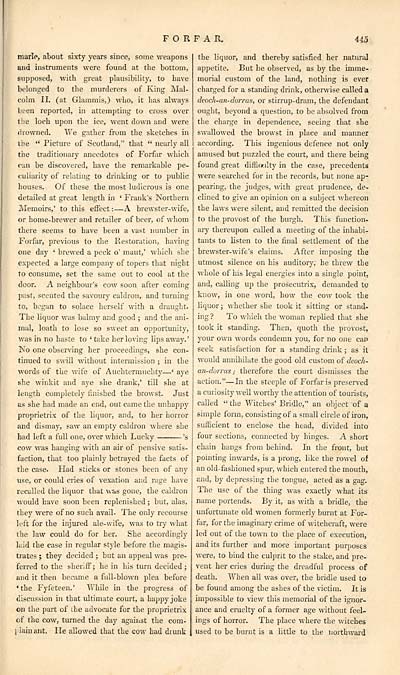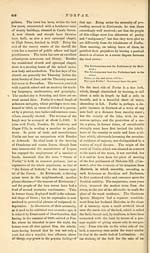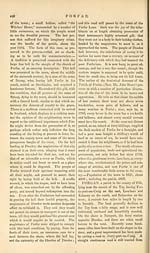Gazetteer of Scotland > Volume 1
(479) Page 445
Download files
Complete book:
Individual page:
Thumbnail gallery: Grid view | List view

FORFAR.
445
marie, about sixty years since, some weapons
and instruments were found at the bottom,
supposed, with great plausibility, to have
belonged to the murderers of King Mal-
colm II. (at Glammis,) who, it has always
been reported, in attempting to cross over
the loch upon the ice, went down and were
drowned. We gather from the sketches in
the " Picture of Scotland," that " nearly all
the traditionary anecdotes of Forfar which
can be discovered, have the remarkable pe-
culiarity of relating to drinking or to public
houses. Of these the most ludicrous is one
detailed at great length in ' Frank's Northern
Memoirs,' to this effect : — A brewster-wife,
or home-brewer and retailer of beer, of whom
there seems to have been a vast number in
Forfar, previous to the Restoration, having
one day ' brewed a peck o' maut,' which she
expected a large company of topers that night
to consume, set the same out to cool at the
door. A neighbour's cow soon after coming
past, scented the savoury caldron, and turning
to, began to solace herself with a draught.
The liquor was balmy and good ; and the ani-
mal, loath to lose so sweet an opportunity,
was in no haste to ' take her loving lips away. '
No one observing her proceedings, she con-
tinued to swill without intermission ; in the
words of the wife of Auchtermuchty — ' aye
she winkit and aye she drank,' till she at
length completely finished the browst. Just
as she had made an end, out came the unhappy
proprietrix of the liquor, and, to her horror
and dismay, saw an empty caldron where she
had left a full one, over which Lucky 's
cow was hanging with an air of pensive satis-
faction, that too plainly betrayed the facts of
the case. Had sticks or stones been of any
use, or could cries of vexation and rage have
recalled the liquor that was gone, the caldron
would have soon been replenished ; but, alas,
they were of no such avail- The only recourse
left for the injured ale-wife, was to try what
the law could do for her. She accordingly
laid the case in regular style before the magis-
trates : they decided ; but an appeal was pre-
ferred to the sheriff; he in his turn decided ;
and it then became a full-blown plea before
•the Fyfeteen.' While in the progress of
discussion in that ultimate court, a happy joke
on the part of the advocate for the proprietrix
of the cow, turned the day against the com-
1 lain ant. He allowed that the cow had drunk
the liquor, and thereby satisfied her natural
appetite. But he observed, as by the imme-
morial custom of the land, nothing is ever
charged for a standing drink, otherwise called a
deoch-an-dorras, or stirrup-dram, the defendant
ought, beyond a question, to be absolved from
the charge in dependence, seeing that she
swallowed the browst in place and manner
according. This ingenious defence not only
amused but puzzled the court, and there being
found great difficulty in the case, precedents
were searched for in the records, but none ap-
pearing, the judges, with great prudence, de-
clined to give an opinion on a subject whereon
the laws were silent, and remitted the decision
to the provost of the burgh. This function-
ary thereupon called a meeting of the inhabi-
tants to bsten to the final settlement of the
brewster-wife's claims. After imposing the
utmost silence on bis auditory, he threw the
whole of his legal energies into a single point,
and, calling up the prosecutrix, demanded to
know, in one word, how the cow took the
liquor ; whether she took it sitting or stand-
ing? To which the woman replied that she
took it standing. Then, quoth the provost,
your own words condemn you, for no one cap
seek satisfaction for a standing drink ; as it
would annihilate the good old custom of deoch-
an-dorras j therefore the court dismisses the
action." — In the steeple of Forfar is preserved
a curiosity well worthy the attention of tourists,
called " the Witches' Bridle," an object of a
simple form, consisting of a small circle of iron,
sufficient to enclose the head, divided into
four sections, connected by hinges. A short
chain hangs from behind. In the front, but
pointing inwards, is a prong, like the rowel of
an old-fashioned spur, which entered the mouth,
and, by depressing the tongue, acted as a gag.
The use of the thing was exactly what its
name portends. By it, as with a bridle, the
unfortunate old women formerly burnt at For-
far, for the imaginary crime of witchcraft, were
led out of the town to the place of execution,
and its further and more important purposes
were, to bind the culprit to the stake, and pre-
vent her cries during the dreadful process of
death. When all was over, the bridle used to
be found among the ashes of the victim. It is
impossible to view this memorial of the ignor-
ance and cruelty of a former age without feel-
ings of horror. The place where the witches
used to be burnt is a little to the northward
445
marie, about sixty years since, some weapons
and instruments were found at the bottom,
supposed, with great plausibility, to have
belonged to the murderers of King Mal-
colm II. (at Glammis,) who, it has always
been reported, in attempting to cross over
the loch upon the ice, went down and were
drowned. We gather from the sketches in
the " Picture of Scotland," that " nearly all
the traditionary anecdotes of Forfar which
can be discovered, have the remarkable pe-
culiarity of relating to drinking or to public
houses. Of these the most ludicrous is one
detailed at great length in ' Frank's Northern
Memoirs,' to this effect : — A brewster-wife,
or home-brewer and retailer of beer, of whom
there seems to have been a vast number in
Forfar, previous to the Restoration, having
one day ' brewed a peck o' maut,' which she
expected a large company of topers that night
to consume, set the same out to cool at the
door. A neighbour's cow soon after coming
past, scented the savoury caldron, and turning
to, began to solace herself with a draught.
The liquor was balmy and good ; and the ani-
mal, loath to lose so sweet an opportunity,
was in no haste to ' take her loving lips away. '
No one observing her proceedings, she con-
tinued to swill without intermission ; in the
words of the wife of Auchtermuchty — ' aye
she winkit and aye she drank,' till she at
length completely finished the browst. Just
as she had made an end, out came the unhappy
proprietrix of the liquor, and, to her horror
and dismay, saw an empty caldron where she
had left a full one, over which Lucky 's
cow was hanging with an air of pensive satis-
faction, that too plainly betrayed the facts of
the case. Had sticks or stones been of any
use, or could cries of vexation and rage have
recalled the liquor that was gone, the caldron
would have soon been replenished ; but, alas,
they were of no such avail- The only recourse
left for the injured ale-wife, was to try what
the law could do for her. She accordingly
laid the case in regular style before the magis-
trates : they decided ; but an appeal was pre-
ferred to the sheriff; he in his turn decided ;
and it then became a full-blown plea before
•the Fyfeteen.' While in the progress of
discussion in that ultimate court, a happy joke
on the part of the advocate for the proprietrix
of the cow, turned the day against the com-
1 lain ant. He allowed that the cow had drunk
the liquor, and thereby satisfied her natural
appetite. But he observed, as by the imme-
morial custom of the land, nothing is ever
charged for a standing drink, otherwise called a
deoch-an-dorras, or stirrup-dram, the defendant
ought, beyond a question, to be absolved from
the charge in dependence, seeing that she
swallowed the browst in place and manner
according. This ingenious defence not only
amused but puzzled the court, and there being
found great difficulty in the case, precedents
were searched for in the records, but none ap-
pearing, the judges, with great prudence, de-
clined to give an opinion on a subject whereon
the laws were silent, and remitted the decision
to the provost of the burgh. This function-
ary thereupon called a meeting of the inhabi-
tants to bsten to the final settlement of the
brewster-wife's claims. After imposing the
utmost silence on bis auditory, he threw the
whole of his legal energies into a single point,
and, calling up the prosecutrix, demanded to
know, in one word, how the cow took the
liquor ; whether she took it sitting or stand-
ing? To which the woman replied that she
took it standing. Then, quoth the provost,
your own words condemn you, for no one cap
seek satisfaction for a standing drink ; as it
would annihilate the good old custom of deoch-
an-dorras j therefore the court dismisses the
action." — In the steeple of Forfar is preserved
a curiosity well worthy the attention of tourists,
called " the Witches' Bridle," an object of a
simple form, consisting of a small circle of iron,
sufficient to enclose the head, divided into
four sections, connected by hinges. A short
chain hangs from behind. In the front, but
pointing inwards, is a prong, like the rowel of
an old-fashioned spur, which entered the mouth,
and, by depressing the tongue, acted as a gag.
The use of the thing was exactly what its
name portends. By it, as with a bridle, the
unfortunate old women formerly burnt at For-
far, for the imaginary crime of witchcraft, were
led out of the town to the place of execution,
and its further and more important purposes
were, to bind the culprit to the stake, and pre-
vent her cries during the dreadful process of
death. When all was over, the bridle used to
be found among the ashes of the victim. It is
impossible to view this memorial of the ignor-
ance and cruelty of a former age without feel-
ings of horror. The place where the witches
used to be burnt is a little to the northward
Set display mode to: Large image | Transcription
Images and transcriptions on this page, including medium image downloads, may be used under the Creative Commons Attribution 4.0 International Licence unless otherwise stated. ![]()
| Gazetteers of Scotland, 1803-1901 > Gazetteer of Scotland > Volume 1 > (479) Page 445 |
|---|
| Permanent URL | https://digital.nls.uk/97430110 |
|---|
| Description | Volume I: Abbey to Glenartney. |
|---|---|
| Attribution and copyright: |
|
| Description | By Robert Chambers and William Chambers. Glasgow: Blackie & Son, 1838. 2 volumes. |
|---|---|
| Shelfmark | NF.1461.g.7 |
| Additional NLS resources: | |

